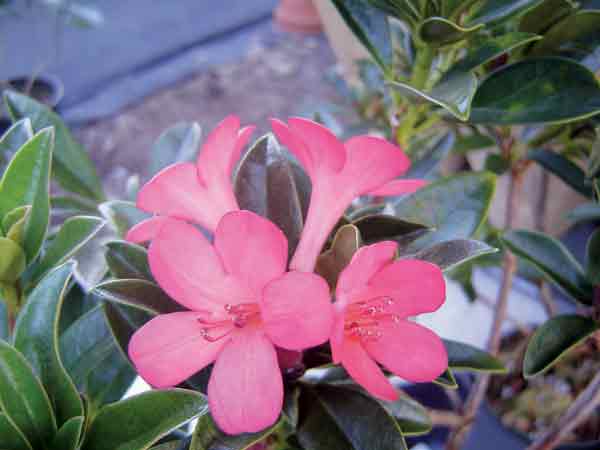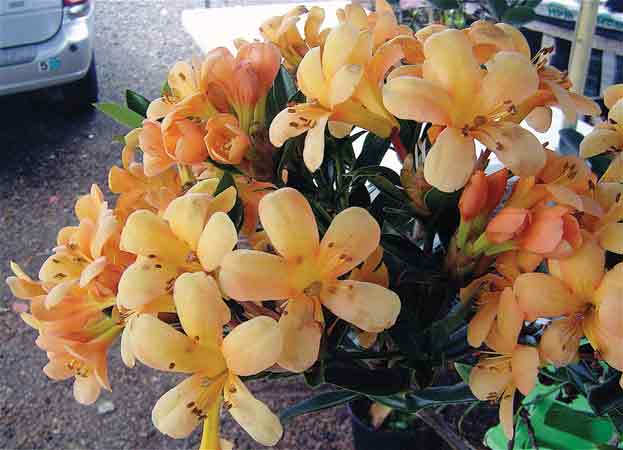JARS v63n1 - I Dare You...I Double Dare You!
I Dare You...I Double Dare You!
Sherla D. Bertelmann
Kea'au, Hawaii
My name is Sherla Bertelmann, a long-time member of the Hawaii Chapter ARS and vireya grower here in Hilo, Hawaii. I've been thinking it over for a while and I can no longer hold it in. I'm referring to growing vireya rhododendrons and why more people aren't growing them, especially those who belong to ARS. Here's the thing, we in Hawaii cannot grow your beautiful temperate rhododendrons. It's not that we don't want to but, rather, our climate prevents them from blooming here. But, YOU can grow a vireya.
When vireyas were reintroduced in the '60 s many of the varieties distributed were often tall, leggy plants that did not do well in pots. Today there are many wonderful varieties very suitable for pot culture.

|

|
|
|
Seedlings of the cross
[(
R. macgregoriae
x
R. laetum
) x
R. saxifragoides
] F
2
x self.
The plants are well suited for pot culture. They are compact, bushy and heavy bloomers. Photos by Sherla D. Bertelmann |
||
Here are a few must requirements for growing success with vireyas. The first two are drainage and air in the medium. Vireyas are more epiphytic in nature than most realize. Orchid growers are the first to grab this concept and will treat their vireyas just as they would their orchids. Besides the medium, vireyas are similar to orchids in wanting bright light, not necessarily full sunlight. Though many varieties will grow in full sun most seem to respond best in dappled light, bright light, or at least some protection from the hot late afternoon sun.
Like orchids, vireyas don't mind being pot tight...but, there is a difference in being pot tight and being root bound. They have a fine root system with a few larger "carrot" roots but no taproot. The fine roots can form a solid barrier in their pots preventing proper water absorption and leading to stress. Vireyas respond to transplanting very well and love having their roots loosened or trimmed. When you repot be sure to prune your vireya, too, which helps it to recover more quickly from the repotting and produces a denser plant that will cover itself with blooms.
Humidity is another shared requirement with orchids. When the humidity is low the vireyas leaves often droop. It's as if the air is sucking out all the moisture in the leaves. Misting the foliage helps to bring up the humidity around the plant.
Keep your plant regularly watered. One of the lessons learned from growing vireyas here in Hilo, Hawaii, is they love water, just not soggy feet. In other words, it's not how much water but how quickly the water runs through. I know, we've all heard we should water heavily and allow the vireya to dry out well before re-watering. Well, Hilo is the rainiest city in the USA and it is not unusual to have a solid month of rain. The vireyas absolutely love it! This has lead us to rethink our watering. Keeping the vireya slightly moistened at all times works better than letting it swing between very dry to very wet - far less stressing on the plant.
Go sparingly with your fertilizer. Time release with trace elements, fish emulsion, rhododendron fertilizers, chicken manure are all things vireyas love, sparingly. Half to one third of the recommend application is fine. Vireyas' favorite seems to be good old organic mulch around its roots, even in a pot if it is kept outside in the elements.
There are many recipes for rhododendron medium. I want to mention one other one: cactus mixes. Believe it or not, vireyas will grow in it because it tends to have exceptional drainage and aeration.
I admit I don't know much about growing plants in areas that have snow, but I know that many of you do grow other plants in pots. I've heard you move them indoors or cover them to protect your plants from freezing. I'm sure there are other things you do that I'm not aware of. But, the point is you can grow vireyas in pots whereas I cannot grow your temperates. So, what are you waiting for - try a vireya. I dare you, I double dare you.
Sherla Bertelmann is past president of the Hawaii Chapter.
